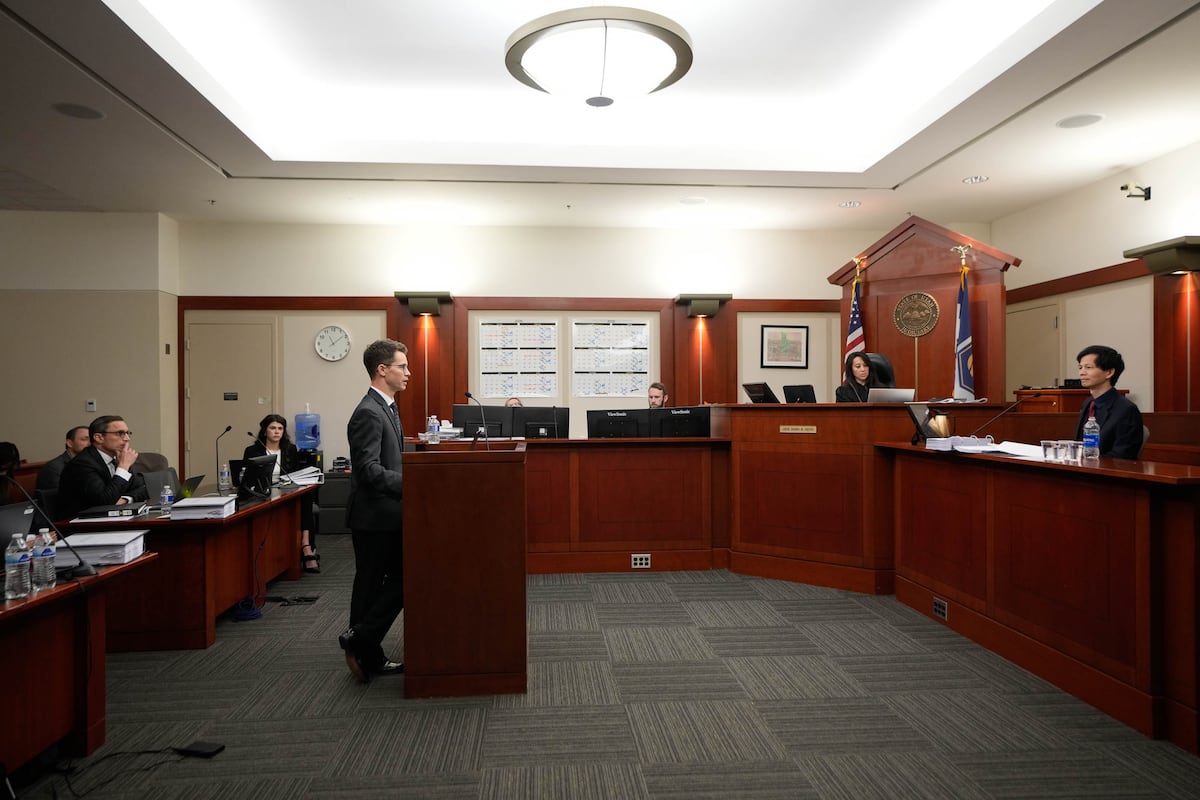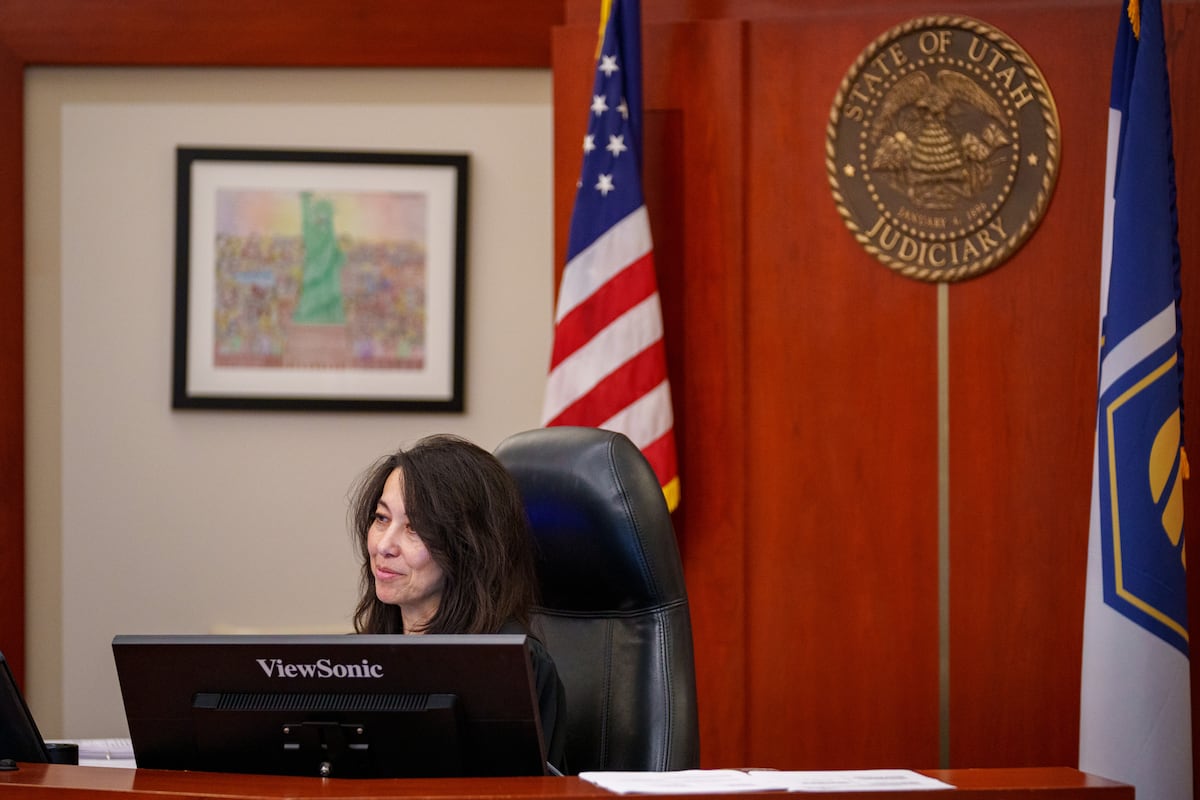Utah Judge Dianna Gibson will hear two days of arguments starting Thursday morning over whether a new congressional map adopted by Republican legislators meets the standards of the voter-passed Better Boundaries initiative or if it is a partisan gerrymander and should be thrown out.
The outcome will determine whether voters will cast their ballots next year in four districts that favor GOP candidates or if there will be at least one district that could be won by a Democrat.
To get there, Gibson, a 3rd District Court judge, will have to wade through hundreds of pages of expert reports, competing computer algorithms, complicated statistical formulas, and hours of testimony in which experts for the plaintiffs are accusing the Legislature of adopting a Republican gerrymander, while the lawmakers’ experts allege the plaintiffs are trying to rig a district for Democrats.
A map needs to be in place by Nov. 10, according to Lt. Gov Deidre Henderson, whose office oversees state elections, in order for county clerks to be ready for candidates to file to run for the U.S. House seats starting Jan. 2.
A key point of contention will likely center on the assertion by the plaintiffs’ witness, Jowsei Chen, a political science professor at the University of Michigan, that the two experts hired by the state — commentator Sean Trende and Brigham Young University Professor Michael Barber — made serious errors in their analysis of the Legislature’s chosen map.
Each of the three experts used computer algorithms to create tens of thousands of maps, supposedly drawn without partisan data and designed to comply with the other redistricting criteria — avoiding splits of cities and counties, making districts contiguous and compact, and preserving communities of interest.
The idea is that if the Legislature’s map looks enough like 95% of the randomly drawn maps, it is reasonable to believe that it wasn’t drawn to intentionally benefit Republicans.
But Chen writes that Trende and Barber failed to follow county lines. Some of Trende’s maps split Utah’s 29 counties as many as 13 times and thus produced a set of comparison maps with zigzagging districts that are not compact and end up looking like Rorschach paint blots.
Those maps don’t meet the most essential redistricting criteria in Utah law, Chen argues, and should not be used as comparisons for Legislature’s map.”
Moreover, Chen’s analysis shows that the more counties split and the less compact Trende’s districts are, the more Republican they lean. If the maps that split counties more than six times are excluded, Chen says, the Legislature’s map is an outlier and fails the partisan bias test.
Barber, Chen said, specifically coded his algorithm to not treat Salt Lake County as a county, which meant it intentionally carved up the most Democratic area of the state and produced Republican-leaning results that made Legislature’s map appear to be less of a gerrymander.
“I find that Dr. Trende’s simulations are deeply flawed to the point of being invalid because they do not account for (and, in fact, badly violate) Proposition 4’s neutral redistricting criteria,” Chen said in his report to the court. “Dr. Trende’s disregard for those criteria in constructing his ensembles caused a striking pro-Republican skew in his set of simulated maps.”
A spokesperson for the Legislature said that Trende could not respond to Chen’s assertion because of the litigation but that he looks forward to taking the stand in court to defend his work.
In a rebuttal report filed Wednesday with the court, Barber counters that Chen’s maps are a type of “black box,” in contrast to the peer-reviewed algorithm the BYU professor said he used and that the court has no way to know if Chen’s maps actually are applying neutral redistricting criteria. Barber argues that Chen’s maps “favor Democratic districts by design.”
How can the judge make her judgment?
Perhaps a more fundamental issue is what metrics Gibson can use to judge whether the Legislature’s map is a partisan gerrymander.
During the special session earlier this month, Republican legislators passed SB1011, sponsored by Sen. Brady Brammer, R-Pleasant Grove. The bill establishes three tests — and only three — that Gibson can consider when gauging if the Legislature’s map unduly disadvantages Democrats.
As Chen notes, the tests chosen don’t work well in a state like Utah with few congressional districts and a large Republican supermajority. The tests chosen actually have the effect of failing maps that create competitive districts while passing maps that have four safe GOP seats.
Additionally, the decision to “cull” maps that fail the test because they create a competitive or Democratic-leaning district — and not use them as a baseline for comparison — means the only maps left to compare the Legislature’s map against are ones that create safe Republican districts.
The plaintiffs want the judge to strike down SB1011, arguing it is a backdoor attempt to undo the voters intent in passing Prop 4 — to prohibit partisan gerrymandering — which the Utah Supreme Court has already said violates the public’s constitutional right to make law via the ballot initiative process.
Attorneys for the Legislature counter that Gibson, in her August ruling, explicitly said that lawmakers could set parameters on what constitutes a gerrymander, which is what it did.
Barber wrote that the tests the Legislature selected are recognized in academic circles. Based on those standards, he said, the Legislature’s map “performs like a typical, neutrally drawn Utah plan” and “does not unduly favor or disfavor either political party.”
Moreover, Barber and Trende reported that the two maps submitted for Gibson’s consideration by the plaintiffs fail the partisan bias tests that the Legislature’s map passes.
GOP consultant’s past courtroom battles
Trende has become a go-to expert for Republicans. He testified as an expert witness in several dozen election cases, including at least 15 partisan or racial gerrymandering cases, according to his biography. He was also one of two experts selected by a court in Virginia in 2021 to draw new boundaries in that state after a bipartisan redistricting commission failed to reach an agreement on political boundaries.
Trende’s primary job is as a political commentator on the RealClearPolitics website and received his doctorate in political science in December 2023.
A copy of Trende’s contract with the Legislature, obtained through an open records request, shows he was paid $500 an hour, up to $10,000, to analyze maps submitted to him by the Legislative Redistricting Committee.
Sen. Scott Sandall, R-Tremonton, co-chair of the committee, said Trende had a separate contract with the Legislature’s outside counsel in the litigation to produce the five maps that were considered by lawmakers.
In a Louisiana redistricting ruling in 2024, the court largely dismissed Trende’s analysis, calling his methods “fundamentally flawed and completely useless,” along with “oversimplistic and unhelpful,” for the purposes of proving maps in that state violated the Voting Rights Act.
An appeals court agreed that the lower court was correct in largely dismissing his assessment.
Likewise, in a Maryland case, the court criticized the “superficial quality of his analysis” and said that “his number crunching had the appearance of rigor but contributed little” to helping the plaintiffs prove their case.
In 2020, while Trende was still in his doctoral program, a court in Georgia rejected him as an expert witness in a lawsuit over wait times at polling places, saying that, while an expert doesn’t necessarily have to have a doctorate, Trende had not written a peer-reviewed article, nor been part of a peer review of another’s work.
The two-day hearing in Gibson’s court will pit Trende against a familiar foe. Earlier this month, Mark Gaber, the attorney with the Campaign Legal Center who is representing the plaintiffs in the Utah case, reportedly had a lengthy and sometimes tense showdown with Trende in a Texas redistricting case.
Trende was testifying on behalf of Texas Republicans who are seeking to redraw the congressional boundaries in that state in such a way that would create five new safe Republican districts. Gaber is the counsel for the parties challenging that redistricting plan as well.




































